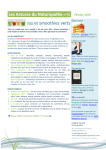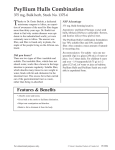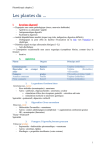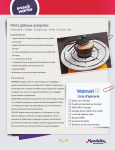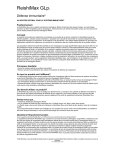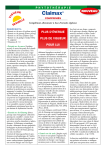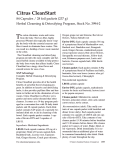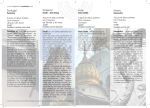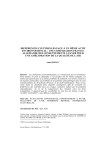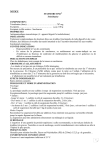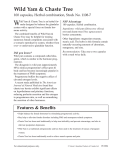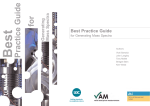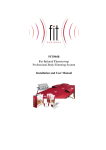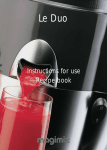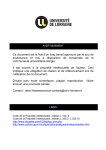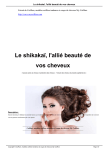Download Licorice - Healthy Alternatives
Transcript
Licorice 100 capsules, Stock No. 420-6; ATC, Stock No. 424-5; Extract, Stock No. 1780-9 L icorice has a long history of use by cultures throughout the world, including the Greeks, Egyptians, Chinese and Hindus. It grows wild in southern and central Europe and is extensively cultivated in Russia Licorice is used in most Chinese herbal combinations to balance the other herbs and to promote vitality. Licorice is one of the great detoxifiers of nature. In fact, in China, licorice root is known as "The Great Detoxifier." NSP Advantage Did you know? Recommendation: Take two capsules with a meal three times daily. The multitude of pharmacological effects of licorice rhizome and roots are practically all attributed to the presence of a triterpene saponin called glycyrrhizin, which is about fifty times sweeter than sugar, and has a powerful cortisone-like effect. In Japan, glycyrrhizin has long been successfully used to treat chronic hepatitis B. This has led to speculation that glycyrrhizin holds promise in the treatment of HIV.1 100 capsules. Single herb. Ingredients: 430 mg of the finest licorice (Glycyrrhiza glabra) root. Recommendation: Take two capsules with a meal three times daily. 50 capsules. Single herb ATC concentrate. Ingredients: 410 mg of the finest licorice (Glycyrrhiza glabra) root and solid root extract, magnesium stearate, silicon dioxide. 59 mL. Liquid Herbal Extract Ingredients: Extract of licorice root (Glycyrrhiza glabra L.). It is extracted in alcohol and/or water and then diluted in water and 15% alcohol to give a final concentration of 1:1. Recommendation: 59 mL Liquid Herbal Extract: Take one-half teaspoonful (2.5 mL) three times daily with water. CAUTION: High blood pressure. Features & Benefits • Licorice is said to have antispasmodic, antiinflammatory, anti-allergic, laxative, and soothing properties. 2,3,4,5,6 • In Chinese medicine, licorice is used for sore throats, abdominal pain, ulcers, bronchial asthma, infectious hepatitis, neonatal jaundice, malaria, tuberculosis, sores, abscesses, food poisoning,diabetes,and contact dermatitis. 4,5 • In vitro, several components of licorice have anti-inflammatory, anti-allergic, and antiasthmatic actions. 2 • In vitro liver-protective activity has been For educational purposes only. reported for some of licorice’s active components. 3,4,5 • Several studies have shown anti-ulcer effects of various components in licorice. 2,3,4,5 • Licorice has been used in cough and cold preparations as an expectorant. 2,3,4,5,6 • Soothes sore, hoarse throat. • Helps fight bacterial, fungal and viral infections. In vitro, licorice constituents have antimicrobial, antibacterial and antiviral activity. 2,3,4,5 • Provides nutritional support to the adrenal glands. © Nature’s Sunshine Products of Canada Ltd. 05/2004 Licorice (continued) 100 capsules, Stock No. 420-6; ATC, Stock No. 424-5; Extract, Stock No. 1780-9 (Licorice contains naturally-occurring amounts of chromium, iron, magnesium, niacin, silicon, and sodium.) 4. The Pharmacology of Chinese Herbs. 2nd Ed. Huang KC. CRC Press. Boca Raton, FL. 1999. References: 5. Encylopedia of Common Natural Ingredients: Used in Foods, Drugs, and Cosmetics. 2nd Ed. Leung AY and Foster S. John Wiley and Sons, Inc. New York. 1996. 1. Balch, James, and Balch, Phyllis, Prescription for Nutritional Healing, A-to-Z Guide to Supplements, Avery, 1998, page 148. 2. The Review of Natural Products. Ed. Ara Dermarderosian. Facts and Comparisons Publishing Group. St. Louis, Missouri. 1998 6. Tyler's Herbs of Choice. Tyler VE, Robbers JE. The Haworth Herbal Press. Binghamton NY. 1999. 3. Herbal Medicines: A guide for Health-care Professionals. Newall CA, Anderson LA, Phillipson JD. Pharmaceutical Press. London. 1996 For educational purposes only. © Nature’s Sunshine Products of Canada Ltd. 05/2004 Réglisse, Concentrée 50 capsules, Herbe simple, No de stock 424-5 L a réglisse a une longue tradition d’usage par diverses cultures à travers le monde, y compris les Grecs, les Égyptiens, les Chinois et les Hindous. Elle pousse en Europe centrale et du sud et elle est abondamment cultivée en Russie. Le réglisse est utilisée dans la majorité des combinaisons d’herbes chinoises pour équilibrer les autres herbes et favoriser la vitalité. La réglisse est l’un des meilleurs dépuratifs de la nature. En Chine, la réglisse est connue comme "Le Grand Dépuratif". Avantages NSP 50 capsules. Herbe simple concentrée ATC Ingrédients: Racine de réglisse (Glycyrrhiza glabra) et extrait solide de racine, stéarate de magnésium, dioxyde de silice. Mode d’emploi: Prendre deux capsules au repas trois fois par jour. AVERTISSEMENT: Tension artérielle élevée. Saviez-vous que? Les effets pharmacologiques multiples du rhizome et de la racine de réglisse sont pratiquement tous attribués à la présence d’une saponine de triterpène appelée glycyrrhizine, qui est presque 50 fois plus sucrée que le sucre et qui a un puissant effet semblable à la cortisone. Au Japon, la glycyrrhizine a depuis longtemps été utilisée avec succès pour soigner l’hépatite B chronique. Ceci en a amené certains à spéculer sur le fait que la glycyrrhizine pourrait s’avérer prometteuse dans le traitement du VIH.1 1. Balch, James, and Balch, Phyllis, Prescription for Nutritional Healing, A-to-Z Guide to Supplements, Avery, 1998, page 148. 2. The Review of Natural Products. Ed. Ara Dermarderosian. Facts and Comparisons Publishing Group. St. Louis, Missouri. 1998 3. Herbal Medicines: A guide for Health-care Professionals. Newall CA, Anderson LA, Phillipson JD. Pharmaceutical Press. London. 1996 4. The Pharmacology of Chinese Herbs. 2nd Ed. Huang KC. CRC Press. Boca Raton, FL. 1999. 5. Encylopedia of Common Natural Ingrédients: Used in Foods, Drugs, and Cosmetics. 2nd Ed. Leung AY and Foster S. John Wiley and Sons, Inc. New York. 1996. 6. Tyler's Herbs of Choice. Tyler VE, Robbers JE. The Haworth Herbal Press. Binghamton NY. 1999. Caractéristiques et Bienfaits • On dit que la réglisse possède des propriétés antispasmodique, anti-inflammatoire, antiallergique, laxative et apaisante.2,3,4,5,6 • En médecine chinoise, la réglisse est utilisée en cas de mal de gorge, douleur abdominale, ulcères, asthme bronchique, hépatite infectieuse, jaunisse du nouveau-né, malaria, tuberculose, plaies, abcès, empoisonnement alimentaire, diabète et dermatite.4,5 • In vitro, plusieurs composants de la réglisse ont une activité anti-inflammatoire, anti-allergique et anti-asthmatique.2 • De nombreuses études ont démontré les effets anti-ulcères d’une variété de composants de la réglisse. 2,3,4,5 • Aide en cas d’ulcères d’estomac et du duodénome. • La réglisse a été utilisée dans des préparations contre la toux et le rhume comme expectorant.2,3,4,5,6 • Apaise le mal de gorge et l’enrouement. • Aide à combattre les infections bactériennes, fongiques et virales. In vitro, les constituants de la réglisse ont une activité antimicrobienne, antibactérienne et antivirale. 2,3,4,5 • Fournit un soutien nutritionnel aux surrénales. A des fins éducatives seulement. © Nature’s Sunshine Products du Canada Ltée 03/2004



